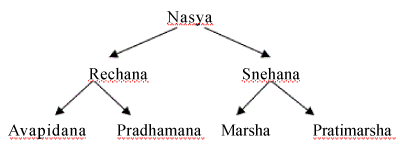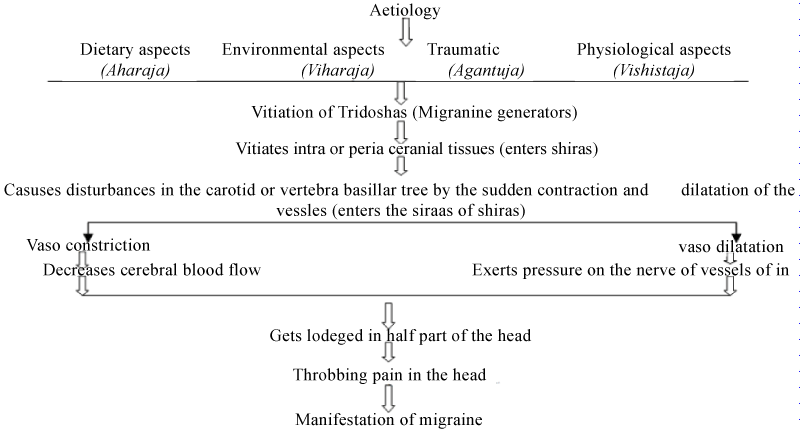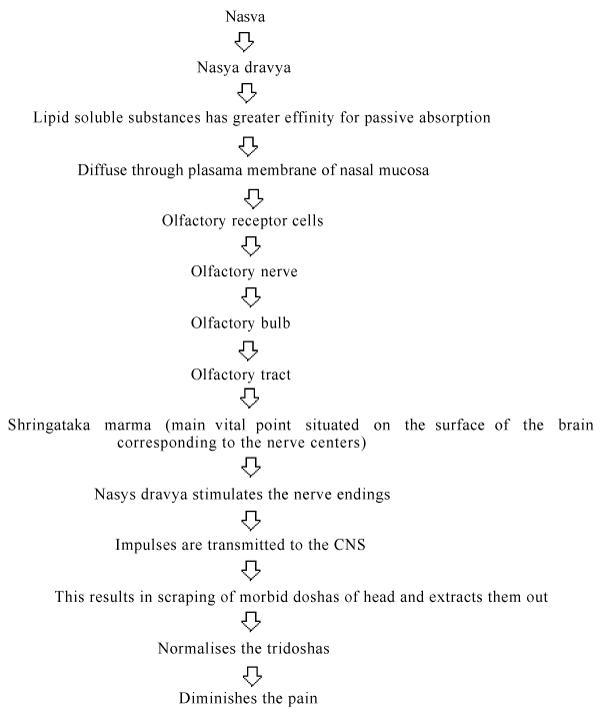Short Communication Open Access
Ayurvedic Resolution to Migraine
| Naveen D* and Praveen kumar T | |
| Department of Shalakya, Dr. BRKR Government Ayurvedic Medical College, Erragadda, Hyderabad, Andhra Pradesh, India | |
| Corresponding Author : | Naveen D, M.S PG Department of Shalakya Dr. BRKR Government Ayurvedic Medical College Erragadda, Hyderabad, Andhra Pradesh, India Tel: 9573703400 E-mail: drnaveendama@gmail.com |
| Received March 15, 2014; Accepted June 27, 2014; Published June 29, 2014 | |
| Citation: Naveen D, Praveen kumar T (2014) Ayurvedic Resolution to Migraine. J Homeop Ayurv Med 3:160. doi: 10.4172/2167-1206.1000160 | |
| Copyright: © 2014 Naveen D, et al. This is an open-access article distributed under the terms of the Creative Commons Attribution License, which permits unrestricted use, distribution, and reproduction in any medium, provided the original author and source are credited. | |
Visit for more related articles at Journal of Traditional Medicine & Clinical Naturopathy
Abstract
Migraine is a familiar disorder characterized by recurrent attacks of pulsatile headache usually unilateral widely variable in intensity, frequency and duration. It is a disorder with numerous manifestations that can involve the brain, the eye and the autonomous nervous system. It is the most common cause of headache which is a neurovascular disease and it often associated with visual disturbances, nausea, vomiting, and hallucinations. It is a benign and reoccurring syndrome of headache associated with other symptoms of neurological dysfunction in varying admixture.
| Introduction |
| Migraine is a familiar disorder characterized by recurrent attacks of pulsatile headache usually unilateral widely variable in intensity, frequency and duration. It is a disorder with numerous manifestations that can involve the brain, the eye and the autonomous nervous system. It is the most common cause of headache which is a neurovascular disease and it often associated with visual disturbances, nausea, vomiting, and hallucinations. It is a benign and reoccurring syndrome of headache associated with other symptoms of neurological dysfunction in varying admixture. |
| Migraine headaches are those which result from a combination of blood vessel enlargement and the release of chemicals from nerve fibers that coil around these blood vessels. During the headache, any artery enlarges that is located on the outside of the skull just under the skin of the temple (temporal artery). This causes a release of chemicals that cause inflammation pain, and further enlargement of the artery. It is, however, believed to be a neurovascular disorder [1,2]. |
| Incidence and Prevalence |
| Migraine, the most common cause of headache, afflicts approximately 15% of woman and 6% of men. About 60% of patients with headaches have tension-type headaches, 35% have migraine and 5% have cluster headaches. A family history of migraine is present in 90% of sufferers. Most studies show a decrease in prevalence in older age groups. Migraine affects slightly more boys than girls before puberty. Globally, approximately 15% of the population is affected by migraines at some point in life. |
| Shiro roga includes the diseases that occur mainly in shiras (head). As per Ayurveda acharyas Shirasoola is the main symptom in all shiro rogas. Shirasoola may be an associated symptom in many general diseases. According to Madhavacharya, Shirasoola is not only mentioned as symptom of various diseases but also considered as an independent disease itself. Althoug shoola is caused by all doshas but vata is the main factor. Charaka mentioned sirashoola as separate disease among 80 types of vata vyadhis. Totally there are 12 types of shiro rogas. Each shiro roga differ according to the character of pain, intensity, site, time of onset, frequency, duration, precipitating factors, relieving factors etc. Ardhavabhedaka is the type of shiro roga. Migraine is described as Ardhavabhedaka in Ayurvedic classics. |
| The word Ardhavabhedaka is made of two words- Ardha + Bhedhaka. Ardha means half or half part. Bhedaka means vidarana - piercing or breaking. Finally the word Ardhavabhedaka means a piercing or breaking type of pain in half part [3,4]. |
| Aetiology |
| Ruksha sevana- taking dry foods. |
| Adhyasana- consuming food immediately before the digestion of previous food, |
| Poorva vata- exposure to direct breeze from east, |
| Avasyaya- exposure to cold or dew, |
| Maithuna- excessive sexual indulgence, |
| Vega dharana- suppression of natural urges, |
| Ati vyayama and ayasa- over exertion etc. |
| Dhuma sevana- exposure to smoke, |
| Atapa and tushara sevana- hot and cold climates, |
| Ambu kreeda- swimming and water games, |
| Atiswapna- excessive or continous sleep, |
| Atijagarana- night arousals, |
| Utsweda- severe sweating, |
| Purovaata- exposure to direct breeze or eastern air, |
| Bhashpa nigraha- suppressing tears, |
| Rodana- weeping, |
| Athyambu madyapana- drinking excess water and alcohol, |
| Krimi- presence of worms, |
| Adhah pratate- looking downward direction, |
| Amadosha- improper direction, |
| Asathmya gandha- unaccustomed smells, |
| Atibhashya- execessive speaking, |
| Upadhana mruja abhyanga dwesha- avoiding pillow, bath and oil application etc. |
| Symptoms |
| The knowledge of symptom is very essential for diagnosis, prognosis and proper management of the disease. The symptoms of Ardhavabhedaka mentioned in classics can be classified as: |
| • Site of pain, |
| • Nature of pain, |
| • Time specified for the attack of pain, |
| • Symptoms |
| Site of the pain: |
| • Ardhashira- half part of the head, |
| • Manya- either side of neck, |
| • Bhru- area between eye brows, |
| • Shanka- temporal area, |
| • Karna- ear, |
| • Akshi- eye orbit, |
| • Lalata- frontal area |
| Nature of the pain: |
| The pain is the sites mentioned above will be of the following nature, |
| • Shastra arani nibham- pain similar to cutting by shastra, |
| • Bhedaka – breaking type of pain, |
| • Thodaka- pricking type of pain, |
| • Manthavat- churning type of pain, |
| • Ati vedana- severe pain |
| Time specified for the attack of Ardhavabhedaka: |
| • Dwayat- once in two days, |
| • Trayat- once in three days, |
| • Dwadashat- once in twelve days, |
| • Pakshat- once in fifteen days, |
| • Mashat- once in a mouth, |
| • Akashmat- sudden/no definite time interval |
| The symptoms of Ardhavabhedaka: |
| • Ativedana in sites mentioned above, |
| • Nishkrushyete evaksheeni- person feels as though his eyes are coming out, |
| • Ghurnateeva shira- realing sensation, |
| • Sandhibhya muchyate- seperatedness of joints in head, |
| • Kandhagaha- stiffness of neck, |
| • Hanugraha- stiffness of jaw, |
| • Prakasamahata- sensitive to light, |
| • Ghrana srava- nasal discharge, |
| • Akasmathvyadhasamatwa- pain occurs and subsides suddenly, Relieving factors: |
| Sometimes the onset of the disease is sudden or regular intervals, and gets reduced by itself. But with the following procedures patients get relief. |
| • Mardhana (massage) |
| • Sneha prayoga (oil usage) |
| • Swedana (fomentation) |
| • Bhandhana (tieing) |
| Aetiopathogenesis |
| Described briefly as flow chart diagram in Figure 1 and Table 1 |
| Treatment principles |
| • Tridosha hara chikitsa |
| • Oral intake ghee + guda |
| • Oral administration of ghrita after meals |
| • Meals with milk or milk products |
| • Shiro vasti with the Chatur snehas |
| • Seka with ghee or milk |
| • Kavalagraha(medicated gargles) |
| • Virechana (purgation therapy) |
| • Vasti (medicated anema) |
| • Rakta mokshana (bloodletting process) |
| • Shiro virechana (nasya) |
| • Hot applications |
| Nasya karma is one of the Panchakarmas mentioned in Ayurveda. Nasya therapy is a process where in the drug (herbalised oils & liquid medicines) is administered through the nostrils. Since the nose is the gate way of the head, the therapy is highly effective in curing number of diseases pertaining to the head. If it is performed systematically, the therapy cleanses & opens the channels of the head, thereby improving the process of oxygenation (prana), which has a direct influence on the function of the brain [5-7]. |
| Nasya yogas |
| • Ksheera sarpi (ghee prepared from milk) |
| • Bringaraj decoction + goat’s milk |
| • Shirisha root or fruit |
| • Vamsha root, karpura + water |
| • Vacha, pippali |
| • Yashtimadhu + honey |
| • Chandana, manishila + honey |
| • Katphala churna |
| • Yashtimadhu, yava, vacha pippali + water + honey |
| • Tuvari dala, doorva swaras |
| • Anu Taila |
| • Shadbindu Taila |
| • Ksheera bala Taila |
| • Danvatari Taila |
| • Kakolyadi Gritha |
| • Gunja Taila |
| Lepa yogas (external applications) |
| • Saarivadhi lepam |
| • Vidanga, Krishna tila, aja ksheera |
| • Tiladi lepam |
| • Maricha, Bringaraja swarasa |
| • Haridra, saariva |
| Probable mode of action of nasya karma |
| Nose is the nearest and easy entry for conveying the medicines to cranial cavity because of “Nasaahi sirasodwaram”. |
| Medicated oil administered through the nose known as nasya, reach the brain and eliminates only the morbid dosha responsible for producing the disease. It doesnot mean that any channel connects directly the brain but they might be connected through the blood vessels or through nervous system. It strengthens the nose, eye, throat, reduces the graying and falling of hair, wrinkling, insomnia, migraine, timira, diminished vision etc. Nasya is a very important procedure in terms of preventive as well as curative aspect mentioned under panchakarma. |
| Many nerve endings which are arranged in the peripheral surface in the mucous membranes, olfactory, trigeminal etc., will be stimulated by nasya dravya. This results in better circulation and nourishment of the organs and diseases will subside [8] (Figure 2) |
 |
| Conclusion |
| Keeping in view of above said facts it can be said that veerya i.e., essence of nasya drug either by stimulating the higher centers of brain though olfactory stimulus regulates the different neurological and endocrine functions or by getting absorbed into circulation does systemic action apart from its local effects. |
References
|
Tables and Figures at a glance
| Table 1 |
Figures at a glance
 |
 |
| Figure 1 | Figure 2 |
Relevant Topics
- Acupuncture Therapy
- Advances in Naturopathic Treatment
- African Traditional Medicine
- Australian Traditional Medicine
- Chinese Acupuncture
- Chinese Medicine
- Clinical Naturopathic Medicine
- Clinical Naturopathy
- Herbal Medicines
- Holistic Cancer Treatment
- Holistic health
- Holistic Nutrition
- Homeopathic Medicine
- Homeopathic Remedies
- Japanese Traditional Medicine
- Korean Traditional Medicine
- Natural Remedies
- Naturopathic Medicine
- Naturopathic Practioner Communications
- Naturopathy
- Naturopathy Clinic Management
- Traditional Asian Medicine
- Traditional medicine
- Traditional Plant Medicine
- UK naturopathy
Recommended Journals
Article Tools
Article Usage
- Total views: 19272
- [From(publication date):
June-2014 - Aug 17, 2025] - Breakdown by view type
- HTML page views : 14477
- PDF downloads : 4795
